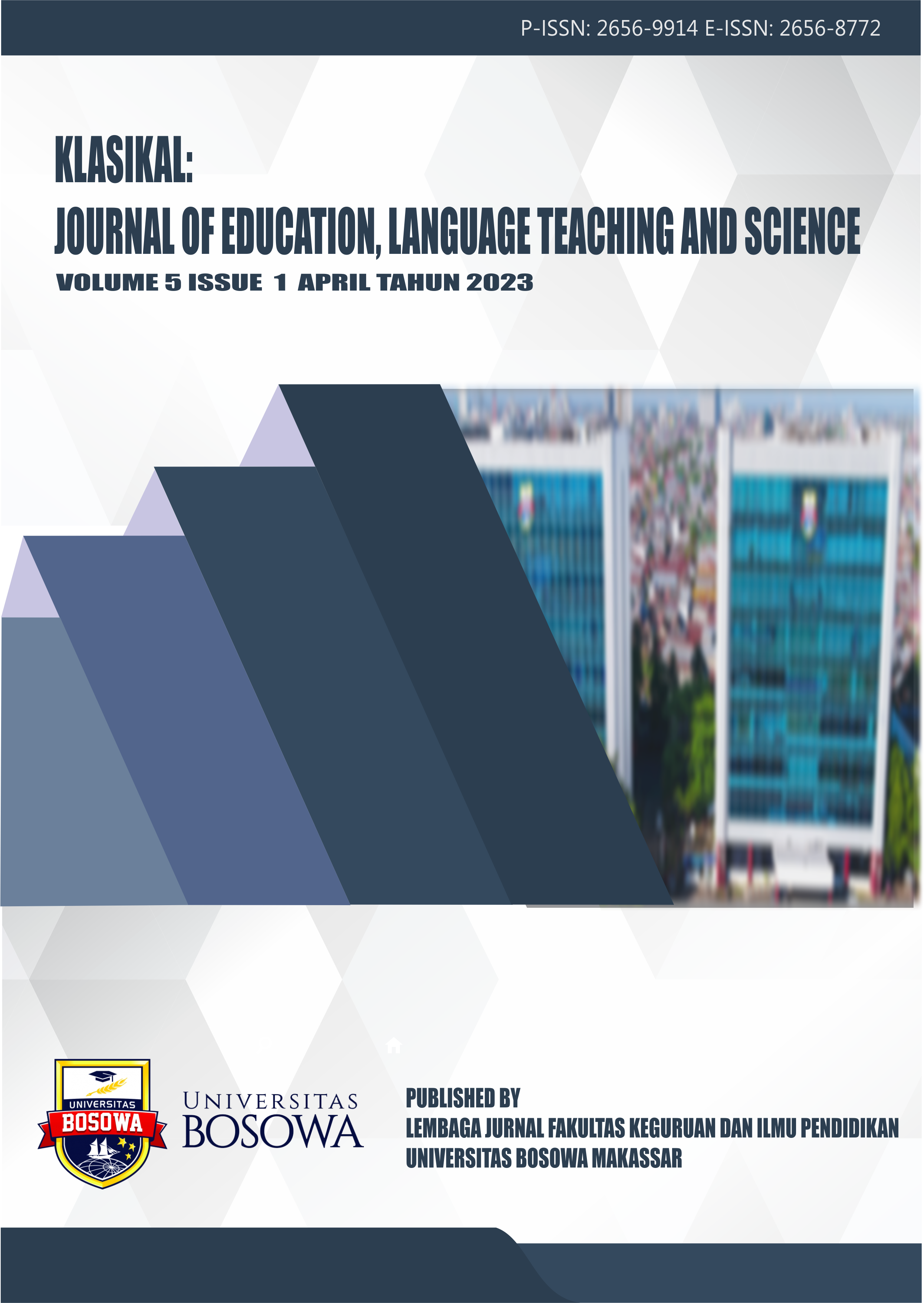WHAT CONSIDERATIONS SHOULD THE SCHOOLS OR TEACHERS TAKE INTO ACCOUNT WHEN IMPLEMENTING ENGLISH-INDONESIAN BILINGUAL PROGRAM IN THEIR SCHOOLS?
DOI:
https://doi.org/10.52208/klasikal.v5i1.628Keywords:
English-Indonesian Bilingual Program, implementation, school, teacherAbstract
English-Indonesian bilingual education (BE) program has been implemented in Indonesia for several decades, starting from primary school to tertiary education both by public and private educational institutions. Unfortunately, many stakeholders have questioned about the result of the implementation of the program in Indonesian schools especially in public or government schools. This article presents five strategies that schools or teachers need to be taken into account if they want to achieve successful English-Indonesian bilingual program, namely: (1) sufficient bilingual teacher supply; (2) ongoing teacher professional development; (3) communicative classroom strategies; (4) English in the school context; and (5) collaboration between language and content teachers
References
Admiraal, W., Westhoff, G., & deBot, K. (2006). Evaluation of bilingual secondary education in the Netherlands: Students’ language proficiency in English. Educational Research and Evaluation, 12(1), 75-93.
Ali, N. L., Hamid, M. O., & Moni, K. (2011). English in primary education in Malaysia: Policies, outcomes and stakeholders’ lived experiences. Current Issues in Language Planning, 12(2), 147-166.
Allwright, D. (2005). Developing principles for practitioner research: The case of exploratory practice. The Modern Language Journal, 89(3), 353-366.
Baa, S. (2018). Lecturer perceptions toward the teaching of Mathematics using English as a medium of instruction at the International Class Program (ICP) of Mathematics Department of the State University of Makassar. Paper presented at the Journal of Physics: Conference Series.
Flores, B. B., Keehn, S., & Pérez, B. (2002). Critical need for bilingual education teachers: The potentiality of normalistas and paraprofessionals. Bilingual Research Journal, 26(3), 501-524.
Gajo, L. (2007). Linguistic knowledge and subject knowledge: How does bilingualism contribute to subject development? The Internatioal Journal of Bilingual Education and Bilingualism, 10(5), 563-581.
Hannafin, M. J., Hill, J. R., & Land, S. M. (1997). Student-centred learning and interactive multimedia: status, issues, and implications. Contemporary Education, 68, 94-97.
Hoare, P. (2011). Contexts and constraints: Immersion in Hong Kong and Mainland China In D. J. Tedick, D. Christian & T. W. Fortune (Eds.), Immersion education: Practices, policies, possibilities (pp. 211-230). Bristol: Multilingual Matters.
Kaplan, R. B., & Baldauf Jr., R. b. (2003). Language and language-in-education planning in the Pasific Basin. Dordrecht, The Netherlands: Kluwer Academic Publishers.
Kirkpatrick, A. (2012). English as an Asian lingua franca: The ‘lingua franca approach’ and implications for language education policy. Journal of English as a Lingua Franca, 1(1), 121-139.
Kowal, M., & Swain, M. (1997). From semantic to syntactic processing: How can we promote it in the immersion classroom? In R. K. Johnson & M. Swain (Eds.), Immersion education: International perspectives (pp. 282-309). Cambridge: Cambridge University Press.
Krueger, R. A. (1994). Focus groups: A practical guide for applied research. Thousand Oaks, Calif: Sage Publications.
Lea, S. J., Stephenson, D., & Troy, J. (2003). Higher education students' attitudes to student-centred learning: beyond'educational bulimia'? Studies in Higher Education, 28(3), 321-334.
Lotherington, H. (2001). A tale of four teachers: A study of an Australian late-entry content based programme in two Asian languages. International Journal of Bilingual Education and Bilingualism, 4(4), 97-106.
Lyster, R. (1998a). Form in immersion classroom discourse: In or out of focus. Canadian Journal of Applied Linguistics, 1, 53-82.
Lyster, R. (1998b). Learning and teaching languages through content: A countebalanced approach (Vol. 28). Amsterdam: John Benjamins.
Maasum, T. N. R. T. M., Maarof, N., Zakaria, E., & Yamat, H. (2012). Content-based instruction needs and challenges in diversified literacy context. US-China Foreign Language, 10(3), 999-1004.
Snow, M. A., Met, M., & Genesee, F. (1989). A conceptual framework for the integration of language and content in second/foreign language instruction. TESOL Quarterly, 23(2), 201-217.
Steven, F. (1983). Activities to promote learning and communication in the second language classroom. TESOL Quarterly, 17(2), 259-272.
Sumintono, B. (2013, 11 January ). RSBI: Problems seen in hindsight, The Jakarta Post. Retrieved from http://www.thejakartapost.com/news/2013/01/11/rsbi-problems-seen
Sundusiyah, A. (2010). Teachers in International-Standard Schools: What is missing? What can be improved? What does it take? Paper presented at the Indonesian Student International Conference (ISIC) 2010, Melbourne.
Swain, M. (1998). Manipulating and implementing content teaching to maximise second language learning. TESL Canada Journal, 6(1), 68-83.
Swain, M., & Johnson, R. K. (1997). Immersion education: A category within bilingual education. In R. K. Johnson & M. Swain (Eds.), Immersion education: International perspectives (pp. 1-16). Cambridge: Cambridge University Press.
Swain, M., & Lapkin, S. (1982). Evaluating bilingual education: A Canadian case study. Clevedon, England: Multilingual Matters.
Tedick, D. J., & Cammarata, L. (2012). Content and Language Integration in K–12 Contexts: Student Outcomes, Teacher Practices, and Stakeholder Perspectives. Foreign Language Annals, 45(s1), s28-s53.
Varghese, M. (2004). Professional development for bilingual teachers in the United States: A site for articulating and contesting professional roles. International Journal of Bilingual Education and Bilingualism, 7(2-3), 222-237.
Zakaria, E., & Iksan, Z. (2009). Promoting cooperative learning in science and mathematics education: A Malaysian perspective. Eurasia Journal of Mathematics, Science & Technology Education, 3(1), 35-39.

Downloads
Published
How to Cite
Issue
Section
License
Copyright (c) 2023 Sultan Baa

This work is licensed under a Creative Commons Attribution 4.0 International License.

Klasikal: Journal of Education, Language Teaching and Science is licensed under a Creative Commons Attribution 4.0 International License.



















